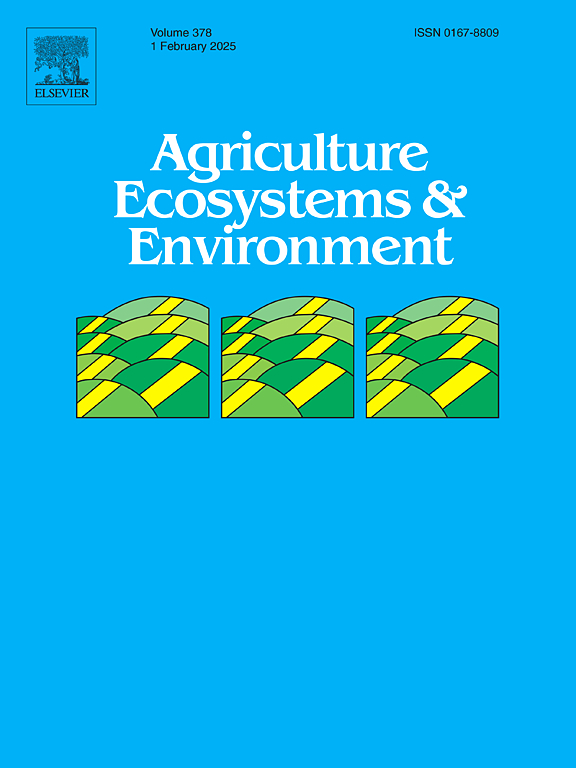Warming but not elevated CO2 depletes soil organic carbon in a temperate rice paddy
IF 6.4
1区 农林科学
Q1 AGRICULTURE, MULTIDISCIPLINARY
引用次数: 0
Abstract
Global climate change has the potential to alter soil organic carbon (SOC) stocks in rice paddies, because increases in temperature and atmospheric carbon dioxide concentration ([CO2]) both influence the primary input (i.e., net primary production, NPP) and output (i.e. heterotrophic respiration) of carbon (C). We used two types of open-top chambers representing present conditions (+0℃, +0 ppm CO2) and projected climate change conditions (+2℃, +200 ppm CO2) to investigate the net effect of climate change on SOC stock in rice paddy. Additional chambers with elevated temperature only (+2℃, +0 ppm CO2) allowed us to quantify the individual effects of temperature and [CO2]. We calculated changes in SOC stock using net ecosystem C balance (NECB) analysis (i.e., the balance between C inputs and outputs). Compared to present conditions, projected climate change did not change grain yield due to a trade-off between the effects of warming and [CO2] on grain yield components. NPP during the fallow season significantly decreased under combined warming and CO2, as the impact of warming outweighed that of elevated [CO2]. However, rice NPP remained unchanged during the cropping season. Warming plus elevated CO2 increased SOC mineralization by 157–429 %, particularly through warming-induced soil CO2 emission during the fallow season. Consequently, climate change conditions decreased (119–271 %) NECB values compared to present conditions, primarily through the response to warming. Our findings demonstrate that rice paddies represent positive feedback on climate change, because accelerated C release from warmed soils will override C gains from NPP under elevated CO2. Reducing SOC depletion in rice paddy agriculture under a changing climate therefore requires conservative soil management practices during the fallow season.
气候变暖而非二氧化碳升高会消耗温带稻田中的土壤有机碳
全球气候变化有可能改变稻田的土壤有机碳(SOC)储量,因为温度和大气二氧化碳浓度([CO2])的增加都会影响碳(C)的初级输入(即净初级生产力,NPP)和输出(即异养呼吸)。我们使用了代表当前条件(+0℃,+0 ppm CO2)和预测气候变化条件(+2℃,+200 ppm CO2)的两类敞口箱来研究气候变化对稻田中 SOC 储量的净影响。在温度升高(+2℃,+0ppm CO2)的附加箱中,我们可以量化温度和[CO2]的单独影响。我们利用生态系统碳净平衡(NECB)分析(即碳输入和碳输出之间的平衡)计算了 SOC 储量的变化。与目前的条件相比,由于气候变暖和[CO2]对谷物产量的影响之间存在权衡,预测的气候变化不会改变谷物产量。在气候变暖和二氧化碳的共同作用下,由于气候变暖的影响超过了[CO2]升高的影响,因此休耕期的净生产力明显下降。然而,水稻在耕种季节的净生产力保持不变。气候变暖加上 CO2 升高使 SOC 矿化增加了 157-429%,特别是通过气候变暖引起的休耕期土壤 CO2 排放。因此,与当前条件相比,气候变化条件主要通过对气候变暖的响应,降低了 NECB 值(119-271%)。我们的研究结果表明,水稻田是气候变化的正反馈,因为在二氧化碳升高的条件下,变暖的土壤加速释放的碳将超过从氮磷钾获得的碳。因此,要在气候变化条件下减少稻田农业的 SOC 消耗,就必须在休耕期采取保守的土壤管理措施。
本文章由计算机程序翻译,如有差异,请以英文原文为准。
求助全文
约1分钟内获得全文
求助全文
来源期刊

Agriculture, Ecosystems & Environment
环境科学-环境科学
CiteScore
11.70
自引率
9.10%
发文量
392
审稿时长
26 days
期刊介绍:
Agriculture, Ecosystems and Environment publishes scientific articles dealing with the interface between agroecosystems and the natural environment, specifically how agriculture influences the environment and how changes in that environment impact agroecosystems. Preference is given to papers from experimental and observational research at the field, system or landscape level, from studies that enhance our understanding of processes using data-based biophysical modelling, and papers that bridge scientific disciplines and integrate knowledge. All papers should be placed in an international or wide comparative context.
 求助内容:
求助内容: 应助结果提醒方式:
应助结果提醒方式:


